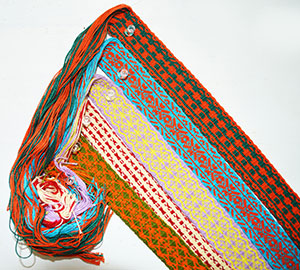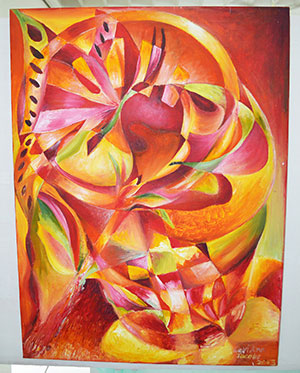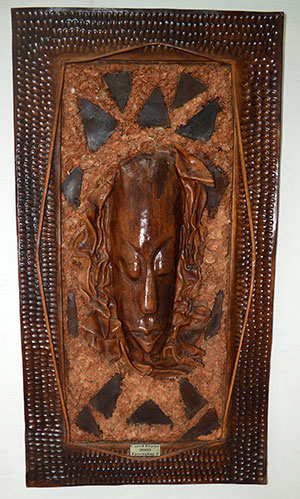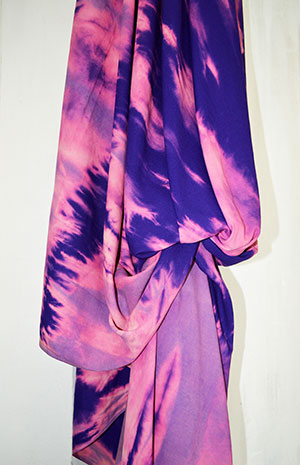By Dominique Hunter
“The challenge these days, is to be somewhere, to belong to some particular place, invest oneself in it, draw strength and courage from it, to dwell in a community.” These words were written by African American feminist author bell hooks in her book titled “Belonging: A culture of place,” and rings true particularly in the case of artists seeking sustainability in Guyana.
One such group, the Guyana Women Artists’ Association (M.S.) has managed to shape for itself a modest framework for sustainability that has worked to varying degrees since its establishment in
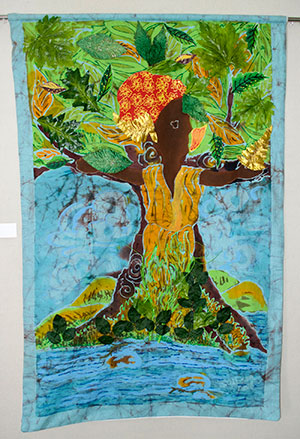
1987. As a collective whose mandate has been to develop a sense of community among women artists, they have survived by finding ways to circumnavigate patriarchal hierarchies.
On Friday, April 22nd the association brought the curtains down on its first weeklong art exhibition for 2016. “Redefining Women’s Work,” as it was titled, presented to the public an opportunity to reopen discussions regarding the measurement of success of its members as well as the success of their individual creative output. Whether the thematic concern was ‘self,’ ‘society’ or anything in between, each member has, through the years, found ways of addressing the multi-layered challenges encountered by them as women first and artists second.
Some members have held on to media traditionally associated with women (for example textiles and ceramics), but have found innovative ways of using the media as the message for underscoring those challenges. Other members have chosen instead to embrace technology and new media as legitimate vehicles for expressing the same concerns in their work.

Myrna Bernard uses her passion for photography and her expansive collection of digital photographs, or ‘raw material’ as she calls them, to create her artwork. Through the use of computer software she manipulates digital photographs to mimic traditional techniques of watercolour, oil and acrylic paintings. Macro shots of landscapes, objects and people are transformed from somewhat recognizable to completely abstract works of art that often take on entirely new meanings post-production.
Beverly Reynolds’ point of entry into the production of her artwork is shaped by very specific memories, emotions and experiences in her life. Her work is characterized by bold and expressive colours, reminiscent of the Jamaican landscape where she was born. Reynolds admits that her latest body of work has, albeit unintentionally, underscored the social realities of the Caribbean space and its people, bringing to the fore moments of humour as well as pain.
Also drawing on her own response to social realities is the painter Lori Ann Jacobs. Speaking on the production of her large-scale abstract works Jacobs had this to say: “As an artist I work hard to develop paintings that speak to me and to others on the challenges of women. My current works in comparison to previous works try to depict women breaking free. As a woman I always felt that we are bound by too many dos and don’ts when compared to men.”
O’Donna Allsopp (GWAA’s most senior exhibiting member) has dedicated her life’s work as a creative practitioner to capturing the beauty of the hidden gems scattered across Guyana. Allsopp has produced over 400 landscape paintings with the hope that upon viewing, locals would be encouraged to explore the richness of Guyana’s hinterland regions. Persons who cannot access those regions are given the opportunity to view them through the artist’s eyes, in the form of her textured and relief-like paintings.
At the core of Aiesha Scotland’s textile construction work is her dependence on her faith to provide a solid foundation for the development of her thematic concerns. She says: “This body of work is based on a song that has blessed me over the years; Music of my heart by Nicole C. Mullen. The words of this song have pierced an inner part of me that really shows how much I can depend on God. […] Like an instrument that needs mending I’m at a point in my life where I need restoration from God.”
Nyota Killikelly uses the symbol of the corn as a metaphor for abundance and prosperity in her latest works. Although she has been known for

producing a sizeable body of paintings in the past, she has chosen to return to textile construction to breathe life into new ideas and concepts. Of her work she says: “I’m fascinated with nature and I love textile construction. That is why I decided to return to this particular medium. I like to explore different options, especially with things related to fabric design and textile construction.”
Tara Bentinck and Merleen Martin-Forde are both textile artists with very distinct methodologies that are unique to each artist. Both women pride themselves on experimenting with materials and techniques to achieve specific qualities in their work. While Martin-Forde sometimes goes a step further by producing complimentary hats and bags for a complete outfit, Bentinck chooses instead to focus on learning new things and perfecting her process.
Danuta Radzik is a multi-disciplinary artist who has, for this exhibition, produced a visually stimulating body of textile work. The range of her design techniques included tie-dye, batik and applique. Those pieces were then transformed into beautifully made dresses, jackets, purses, and even place mats. Speaking on what drives the production of her work Radzik had the following to say: “I am particularly inspired by Guyana’s amazing natural and interior environment, its diversity of peoples and history.”
Jennifer Gibson is a Barbadian-born mixed media textile artist who specializes in the Tulus batik technique. Her work is often characterized by the use of almost every imaginable textile design technique. Gibson draws heavily on the beauty of nature as well as her own life experiences (good and bad) to create specific narratives. Of her work she says: “I see art as a personal appreciation for God’s creation, and elevation for my life in general. I hope to showcase the diversity, and variations of the batik art form through my work.”
Elizabeth Deane-Hughes is another mixed media artist who draws inspiration from the “dynamic, free-flowing, fluctuating and unpredictable elements of nature,” as she describes it. The focus of her production of work rests squarely on the interaction of different materials. Deane-Hughes experiments with layering options and various etching techniques to create multi-dimensional works of art. She says: “Each mixed media piece is its own story that explores my internal landscape. It is about my journey through years of emotions and energies layered on each other and the deconstruction thereof and therefrom.”
Anna Correia-Bevaun has, for this exhibition, produced a number of drawings that are just as strong in the use of colour as they are in the intricate line work that covers the entire picture plane of each piece. Since her departure from ceramics, Correia-Bevaun has proven herself equally proficient in the execution of 2D works, both paintings and drawings. Her artworks also point to a preoccupation with pattern designing as well as isolating and juxtaposing “ordinary” objects to create new and exciting compositions.
Carol Fraser is a multi-disciplinary mixed media artist and designer who specializes in using natural fibers and recycled materials to create her works of art. She has dedicated her entire creative practice to constructively using those materials in an attempt to promote and encourage persons to join the organic art movement. Fraser says: “Although I have developed a love for utilizing the natural resources our natural habitat possesses, leather art still manages to be my greatest joy.”
Through its continued efforts, the association attempts to highlight the gendered group treatment that has worked both to its advantage and disadvantage in the past, and to also find routes to a more inclusive environment within the local arts community for its members. By encouraging the redefinition of art practices typically associated with women artists, they have effectively opened conversations beyond the traditional Western canon to carve out a space for Guyanese women artists.




.png)





